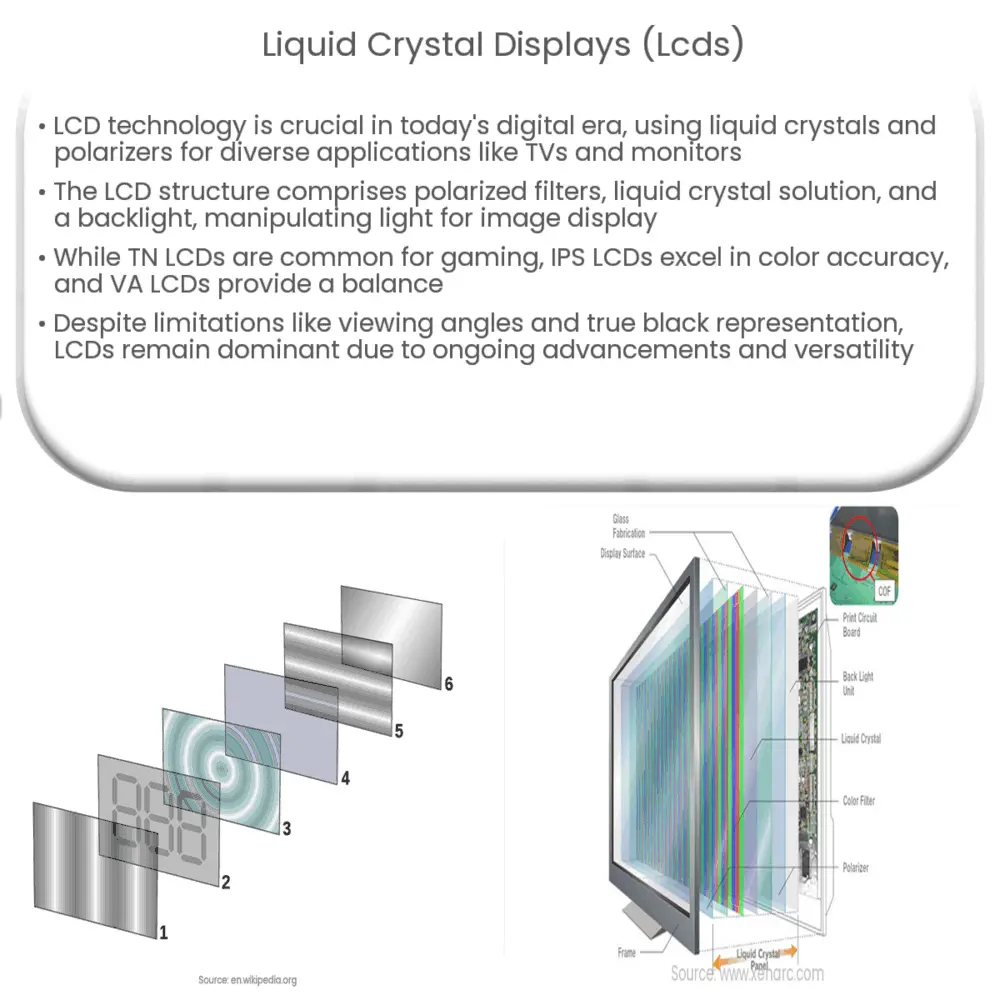Explore the intricacies of LCD technology, its applications, advancements, and limitations in our comprehensive guide to Liquid Crystal Displays.

Introduction to Liquid Crystal Displays (LCDs)
Liquid Crystal Display (LCD) technology is a critical component in our modern digital world. It is a flat panel display technology that uses the light modulating properties of liquid crystals combined with polarizers. LCDs are commonly used in a wide array of applications including televisions, computer monitors, instrument panels, and more.
Structure and Working Principle of LCDs
At a fundamental level, an LCD is made up of several layers. These include two polarized panel filters, a layer of liquid crystal solution, and a backlight. The magic of LCDs lies within the unique properties of the liquid crystal solution, which is composed of rod-shaped microscopic molecules that align in a specific direction.
When an electric current is applied to these molecules, they can be made to twist in a way that changes their alignment. This change in alignment affects the orientation of the light passing through them. By precisely controlling the amount of electric current, it is possible to control the amount of light that reaches the viewer, creating an image.
The Role of Backlight in LCDs
Unlike other display technologies such as OLEDs, LCDs do not produce their own light. This is where the backlight comes in. The backlight illuminates the liquid crystal layer to make the image visible to the viewer. In most modern LCDs, LEDs (Light Emitting Diodes) are used as the backlight because they are energy efficient and can provide a uniform light source.
- Twisted Nematic (TN) LCDs: TN LCDs are the most common type of LCD. They offer fast pixel response times and are therefore great for fast-paced applications such as gaming. However, they have relatively poor color accuracy and viewing angles.
- In-Plane Switching (IPS) LCDs: IPS LCDs offer superior color accuracy and wider viewing angles compared to TN LCDs. They are the preferred choice for tasks that require accurate color representation, such as photo editing.
- Vertical Alignment (VA) LCDs: VA LCDs offer a middle ground between TN and IPS LCDs. They have better color accuracy and viewing angles than TN LCDs, and better contrast ratios than IPS LCDs.
Each of these types has its own strengths and weaknesses, making them suitable for different applications.
Advancements in LCD Technology
Over the years, LCD technology has seen significant advancements. One such advancement is the introduction of Quantum Dot technology, which dramatically improves the color gamut and energy efficiency of LCDs. Quantum Dot LCDs use a layer of quantum dots that emit light of a specific color when illuminated by the backlight, resulting in more vibrant and accurate colors.
Another significant development is the advent of High-Dynamic-Range (HDR) technology. HDR improves the contrast ratio of the display, meaning the difference between the brightest whites and the darkest blacks that the display can produce. This results in a more realistic and immersive viewing experience.
Challenges and Limitations of LCDs
Despite the numerous advancements and widespread usage, LCD technology does have a few limitations. One of the main issues is the limited viewing angle. Unlike OLEDs, the image on an LCD can appear washed out or distorted when viewed from an angle. However, this has been significantly improved in newer IPS and VA panels.
Another issue is that LCDs cannot display true black, as the backlight always emits some amount of light. This results in lower contrast ratios compared to OLEDs, which can turn off individual pixels to display true black.
Conclusion
In conclusion, Liquid Crystal Display (LCD) technology has revolutionized the way we consume digital content. Its versatility and adaptability have allowed it to be used in a wide range of applications, from small mobile devices to large television screens. While it does have certain limitations, continual advancements in technology are constantly improving its performance and efficiency. Despite the emergence of new display technologies, LCDs remain a popular and reliable choice for many display applications, testament to the robustness and maturity of the technology.

